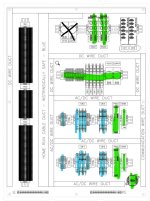i have a customer who is pushing back on something i have not encountered before. the cabinet is a local control panel consisting of PL, PB, HMI, and two fiber converters. CL1, DIV2 with a purge. blue is 120v stuff, green 24v. everything on the left of the TBs are going to the door, everything on the right is coming from their homerun cables.
comments on submitted drawings were "AC/DC wires shall not run in the same duct. At least 2in spacing shall be maintained between AC & DC duct. Also show the 2" inside the Layout."
NEC says i can do it as long as insulation rating is good enough for highest voltage, nothing in ul508a, so what gives other than this is a preference? i have asked them to provide code to support their comment but nothing as of yet. as you can see space is at a premium, ive been shuffling things around to see if i can accommodate the request but cant come up with a solution. making the enclosure larger is not a feasible option.
is there a technical reason for the separation that i am missing?

comments on submitted drawings were "AC/DC wires shall not run in the same duct. At least 2in spacing shall be maintained between AC & DC duct. Also show the 2" inside the Layout."
NEC says i can do it as long as insulation rating is good enough for highest voltage, nothing in ul508a, so what gives other than this is a preference? i have asked them to provide code to support their comment but nothing as of yet. as you can see space is at a premium, ive been shuffling things around to see if i can accommodate the request but cant come up with a solution. making the enclosure larger is not a feasible option.
is there a technical reason for the separation that i am missing?



